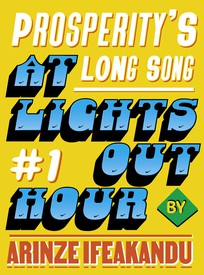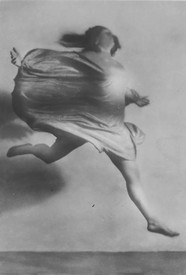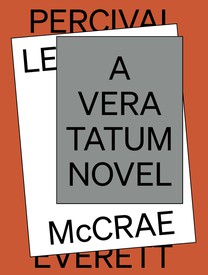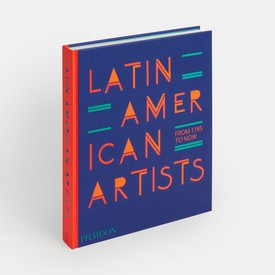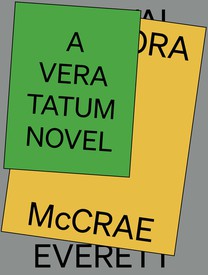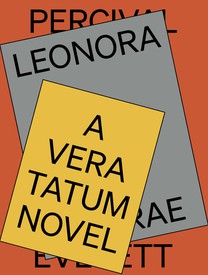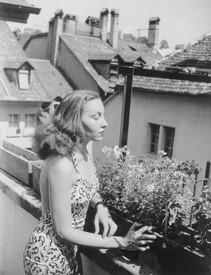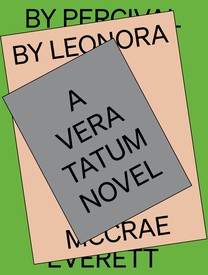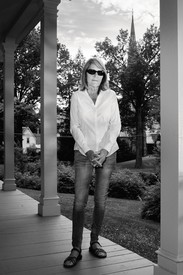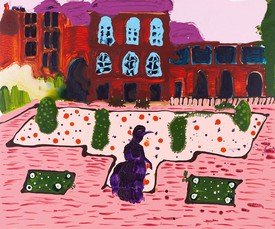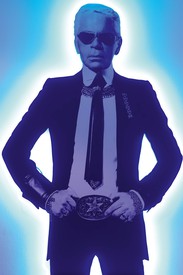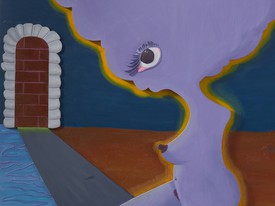
Francine Prose’s most recent novel is The Vixen (2022). Other books include Caravaggio: Painter of Miracles, Peggy Guggenheim: The Shock of the Modern, Reading Like a Writer, and Lovers at the Chameleon Club, Paris 1932. The recipient of numerous grants and awards, she writes frequently about art. She is a distinguished writer in residence at Bard College.
The billionaire is so generous with his recreational drugs that from the moment they wake up until the moment they fall asleep, everything seems hilarious. Every sunny morning, which is to say, every morning, Mattie says, “Let’s go out and lay by the pool and accelerate the aging process.”
It cracks Lee and Mattie up. The aging process is for giant wheels of cheese, for pheasants turning green, for whiskey in barrels bigger than the art-school apartment where they met and fell in love, back when they were poor. They will never get old—a conviction both secretly hold but that they have never discussed, A, because it is boring, and B, because both secretly fear that their belief in eternal youth might not withstand the scrutiny of reason. And C, because both of them are superstitious and afraid to jinx themselves.
They would love to spend a few more days at the billionaire’s house on the channel or canal or archipelago or inlet or whatever the body of water is. But this coming Monday, someone’s intern and someone else’s assistant will be pushing food-cart-sized racks of clothes into Lee and Mattie’s loft for a fashion shoot. An hour or so later, hair and makeup will arrive, dragging their pressed-aluminum wheelies and their fabulous tattoos. Their all-time favorite was a guy who had a Keith Haring squalling baby in three colors on the inside of his forearm. He was a little older than most makeup people, and he was surprised by their enthusiasm: did they even know who Keith Haring was? Of course they knew who Keith Haring was, and they shared the good feelings that came from the dead hero-artist being immortalized on the make-up guy’s arm.
The other reason they need to get home is that neither Lee nor Mattie has picked up a paintbrush in months. And they tell each other (and themselves) that they can’t wait to get back to work.
On the flight home from Miami, they each drink two airplane signature cocktails—doubles, actually—and Mattie says, “Enjoy this moment, darling. You know it’s not going to last.”
It’s true. They both know the odds, which are zero in their favor. It couples are only it couples for the briefest moment, social darlings are only social darlings for a heartbeat. That is the meaning of itness. That is the nature of social darlingness. But every so often an it couple becomes an icon, like Frida Kahlo and Diego Rivera.
After the second cocktail, Lee says that Mattie is being pessimistic, which is true, and that Mattie is always pessimistic, which is untrue. Lee and Mattie take turns being light and dark, realistic and hopeful. Like Mattie, Lee doesn’t really believe that their shining moment will endure, but Lee thinks, Why spoil their present joy with worries about a future that might never happen?
Lee and Mattie wear the same size, they’re the same height and weight, but there are always two racks of designer clothes brought in for the fashion shoots: men’s clothes, women’s clothes. Each of them is free to choose from either rack, to mix and match, to try on garments, wigs, and accessories in any combination. It helps that both Mattie and Lee are gorgeous examples of any gender anyone can imagine. They’re equally androgynous, if such a thing can be measured. It’s loads of fun for the stylists, and though Mattie and Lee used to think that only one magazine would want to do this, every magazine seems to want to do what the others have already done.
Their New York dealer, Sandor, is delighted by everything that’s happened. Free publicity, lavish dinners, invitations to stay at the beach houses of billionaire collectors. Fun for all, money for everyone, good news up and down the food chain.
In interviews, Lee and Mattie thank their moms for giving them gender-neutral names. They like playing with gender in their work and in their private lives, and they believe in absolute and (if they choose) perpetual gender fluidity, which includes their right to remain silent—to refuse to talk about—which gender they identify as, even with one another. They insist that the subject never comes up, in their personal relationships or in their work. They have no interest in marriage or children, and as far as anyone can tell, their parents seem to have conveniently disappeared after giving them the perfect nonbinary names. Of course they know that any jealous art-world gossip or diligent reporter could track down their birth certificates or their high school yearbook photos, but the resultant outcry against whoever outed them would be a billion times worse than when Elena Ferrante was outed, besides which, that didn’t make her books stop selling. If anything, it helped.
Their itness comes partly from their youth and beauty, from their sense of style. But they are also good painters, very good painters, at a time when so few artists paint any more, or care about painting. They make people care about painting.
Though they share the same studio and show together at the same galleries here and in Europe, and though they frequently serve as one another’s models, and often paint each other from photographs and from life, their work is very different. Mattie paints large, lush, thickly painted nudes of Mattie’s head on Lee’s body, and of Lee’s head on Mattie’s body, while Lee works in something closer to an old master style—fragments of Mattie glimpsed from the back, a whirl of hair, the side of a head, the corner of a shoulder, always with a Netherlandish-style landscape in the background. The landscape isn’t painted from life, but based loosely on the photos Lee takes of the garden that the couple grow together in their summer house just outside Hudson.
They’ve incorporated as Muse × Two. Muse was already taken.
Their nasty sunburns from that final day at the billionaire’s beach house are not only painful but (politically, culturally, aesthetically) as wrong as wrong can be. They have to cancel the fashion shoot and they don’t leave the studio for a week. All of this turns out to be the best thing that could have happened. They order out for food and spend all their time painting. Their sunburns are a blessing in disguise, compelling them to suspend their social-darling lives and to return to being artists. It’s also fortunate—provident, really—because they have a show coming up in April.
A few weeks before the show opens, three critics pay separate studio visits to see the new work. The critics look and nod and say nothing. They ask Mattie a few questions but seem to have no questions for Lee.
The critic who files first (for a small art journal) writes a review that Mattie and Lee might not even have seen if Sandor hadn’t brought it to their attention.
Sandor reads it to them on speaker phone.
The critic has written that Mattie’s work has continued to grow, with its increasingly sly challenges to embodiment and gender. Whereas Lee’s painting, the essay says, is in danger of becoming derivative and static. . . . In fact, the critic writes, Lee’s work not only made the critic think about other artists, but it made him wish that he was looking at those other artists, among them Vermeer and Bonnard.
Mattie looks at Lee and mouths “Bullshit,” but Sandor is already saying an almost unforgivable thing: despite the critic’s opinion, Sandor says, Lee’s work may actually prove easier to sell. Buying Lee’s paintings is less of a commitment, less of a . . . statement.
The second two critics seem (at least it seems that way to Mattie and Lee) to have read the first critic’s review, and they say, in more or less the same words, that Mattie’s work is breaking new ground while Lee’s is losing its edge.
They tell Sandor that they want to call the show Breaking the Losing Edge, but he says it would be double suicide, under the circumstances. When they insist, he says, Fine, if that’s what they want to do, fine. It’s their call.
First Mattie caves, then Lee.
They call the show New Work.
Mattie says they’re in this together. Lifetime contract, says Lee.
In the past, Sandor always phoned on the studio landline, and they’d put the call on speaker phone so all three could talk. But now, for some strange reason—a reason that seems stranger to Mattie than it does to Lee, who understands why Sandor is calling—Mattie’s phone rings and Sandor’s picture comes up.
Mattie’s work has sold out well in advance of the show, whereas it’s “still up in the air” what will happen with Lee’s.
All the reviews say the same thing. Progressing. Standing still. Fresh. Familiar. Cutting edge. Old story. Like. Don’t like. Buy. Don’t buy.
Not until the show comes down does Sandor tell them what they already know, or at least suspect: Mattie has sold out, and has orders for future work, while Lee has failed to sell even one painting.
It’s a shock, a blow, and they decide to go to Venice to heal. They went there when their work first started making real money. They spent the weekend in a suite at the Gritti Palace and ordered Champagne from room service and made love from morning to evening, emerging only, like vampires, to prowl the nighttime city, the dark alleys empty and silent but for the sloshing of water and the echo of their footsteps. Like Julie Christie and Donald Sutherland in Don’t Look Now, but without the scary red dwarf. Sometimes they stopped and made out in doorways until their knees were so weak they could hardly stand.
This trip, there’s no making out in doorways. It’s February, and they’d thought the city would be empty, but—surprise!—it’s carnival, and the doorways are crowded with rich Italian families in eighteenth-century gowns and velvet breeches and tricornered hats, and with elderly British people dressed as cardinals and nuns, all seeking shelter from the rain. It’s a nightmare, Mattie and Lee agree, but not a sexy nightmare like the nightmare in the film.
They still have plenty of the money they earned together, but this time Lee can’t seem to shake the thought that Mattie is paying the bills. Is Mattie thinking the same thing? Lee’s not going to ask. It does nothing for their libidos and at night they lie in bed watching Italian soap operas and squabbling about what they’re going to do the next day. Lee wants to turn off the sound on the TV, but Mattie says they can learn Italian that way. They have sleepy sex, with the TV on, and one of the things that makes it so unsatisfying and detached is that both are thinking (and trying not to think) about the last time they were in Venice.
One night, returning to the hotel from a restaurant whose food wasn’t as good as they remembered, Lee thinks they’re being followed. They’re not. The footsteps turn off and cross a different bridge. Lee’s relieved, but Mattie won’t let it go. Who did Lee think was following them? Who’s the pessimist now?
They have agreed not to check their messages until they get back to New York. They return home to find Mattie’s inbox full of invitations to give talks and attend conferences and accept residencies in glamorous cities and beauty spots throughout Europe and Latin America. Lee is never mentioned in these emails, though a few of the residency websites mention that spouses are welcome but cannot expect to be given studio space.
Mattie offers to turn everything down, but Lee says that would be self-defeating. Both of them will suffer if one takes a hit for the other. Together they stand, divided . . . and so forth. Besides, who knows how soon there will be a reverse, and it will be Lee’s turn to prosper. They are there, fully present, for one another. Muse × Two indivisible.
Invited to run a program in Romania helping young artists to paint murals on abandoned apartment buildings, Mattie has the kids paint pictures of Venice, which makes the residents laugh, because Bucharest is not Venice, and also a little sad, because Bucharest is not Venice. Even as Mattie is on the plane back to New York, the Bucharest project is nominated for an international prize.
While Mattie is still on the plane, Lee sleeps with Sandor’s attractive gallery assistant, in the bed that Lee shares with Mattie, and where Mattie finds them (where Mattie is meant to find them) on coming home from the airport.
Mattie says, The big disappointment, the biggest disappointment, is finding out that Lee is jealous and vindictive because Mattie is, at the moment, more successful. It’s the first time that either has acknowledged this. In another situation, it might have ended the conversation, but Mattie is angry, Lee is defensive. Lee and the assistant got drunk, and the assistant made the first move, though obviously the assistant knows that Lee and Mattie are a couple. Mattie was gone, not picking up the phone. What was Lee supposed to do?
There was spotty reception in Bucharest. It was hard to call. Mattie has told Lee that, many times. Lee’s excuses are not excuses.
They consult a couples therapist, a fact they keep secret because, A, it’s boring, and B, it doesn’t fit with their image. But not even professional help can save the love that has descended into sniping and suspicion, each of them make belittling remarks about the other’s talent, insults that they instantly take back but it’s already too late. They make an effort to do things that are supposed to be fun, but aren’t fun, because of the effort involved.
When their breakup becomes public, they agree not to see each other for at least a year. Mattie becomes the it person and Lee takes a one-year teaching gig in Nebraska. Lee’s faculty colleagues are married or resentful to the point of not wanting to be seen with Lee for fear of alienating the other teachers. The students are off-limits romantically, and Lee wastes both semesters pretending to paint and grieving over Mattie.
When Lee returns to New York, Mattie is opening a solo show, not at Sandor’s gallery but somewhere much more prestigious. Lee is not invited to the opening, nor would Lee go if Mattie tracked Lee down and begged Lee to be there. But Lee does drop by to see the show, in the middle of a weekday afternoon, a safe ten days after it opens.
Mattie’s canvases are still large and flashy, but the style has changed. They’re more like Lee’s, more wrist painting, more nods to the old masters. Each painting depicts the inside of a cave. A hairy person of indeterminate gender is painting on a wall. The cave paintings are very beautiful, not exactly like the cave art people know. They make Lee think of the paintings Audubon would have done had Audubon been a cave dweller, and more than anything, Lee longs to be able to say this to Mattie.
Mattie and Lee used to talk about visiting Lascaux and Altamira, even if they could only see the replicas next door, models of the caves constructed to preserve the originals. On the cave walls in Mattie’s paintings are herds of bison, antelopes, wading birds, but also zoo and circus animals, elephants and tigers. A nod to Edward Hicks, to The Peaceable Kingdom. One of Lee’s favorite artists.
The cave paintings are different on every canvas but the cave dweller is the same in painting after painting, hunched and hairy, barely human, but in every other way looking more or less exactly like Lee.
Lee stands in the middle of the gallery, astonished and frozen. It feels a lot like the time Lee thought they were about to be mugged in Venice. Now too Lee thinks Help! and looks around for someone who could intervene, someone with the authority and the power . . . to do what? To take these paintings off the wall? Lee would never do that.
The receptionists seem to be staring, just as they were when Lee walked in. They know who Lee is. They are watching Lee’s reaction, but Lee’s not going to give them that. Lee walks from painting to painting—Lee the cave artist painting a dog, Lee the cave artist painting a dragonfly of exquisite beauty. In the last painting the cave dweller who looks like Lee is wielding a club instead of a paintbrush.
And then there’s a little drawing, smaller than the paintings. Lee looks at it long enough to see that the cave person, Lee, is crouched beside a fire and eating the arms and legs of small children. It’s like one of Grimms’ fairy tales only set in a cave. Does this signal that Mattie was lying about not wanting children? Does this mean that Mattie blames Lee? Lee thanks the receptionist and leaves, trying not to run.
Is this libel? Defamation of character? Should Lee consult a lawyer? Lee cannot bear to imagine how hard the imaginary lawyer will laugh at the skinny young artist who comes in to complain that a former lover is painting pictures of Lee as a Cro-Magnon. Expensive pictures? the lawyer asks. In that case, something might be done. Were they married? How long did they live together? Lee imagines explaining to the imaginary lawyer that it’s not money but . . . what? The fantasy ends when Lee tries to imagine telling the lawyer what charges should be brought. Lee just wants those pictures not to exist. Lee wants to still be enjoying that golden moment with Mattie, being in love, joking about getting toasted on the lounge chairs beside the billionaire’s pool. Lee wants what half the world wants: to make time run backward to the point before the fatal mistake.
Lee tries to paint, but the phrase “going through the motions” seems like a wildly positive euphemism to describe the situation. So Lee retreats for another year, this time to Montana, to teach at an art college so small that they may never have heard about Lee’s problems. More likely they know the whole story and want Lee around as an object lesson. The art world Ozymandias. Behold how the mighty have fallen.
Once again it’s a full year before Lee returns to New York. Lee’s started painting again, tentatively, but at least it’s a start, and there’s a little something to show a few dealers who have politely pretended that they want to look. On the way to the first appointment, Lee passes one of the very top galleries. Lee is surprised to see (in fact Lee isn’t at all surprised to see) that there is yet another show of Mattie’s paintings, with the original title New Work.
The gallery represents yet another, higher rung on the ladder that Mattie is climbing. Pushing open the heavy door to the gallery, Lee feels glad that things are going so well for Mattie and makes a resolution not to feel angry or ripped-off if Mattie is still painting Lee, and by the new (and possibly even more unflattering) uses to which Mattie has put Lee’s image.
Mattie’s gone back to painting enormous nudes, with a generous, thickly loaded brush. Giant, glorious male nudes, this time a man’s body and a man’s face, the face and body of a man as beautiful as one of Caravaggio’s boys, though hunkier and more “masculine.” Why was Mattie pretending not to care about gender only to wind up celebrating this clichéd specimen of male beefcake?
Lee is shocked by the change in Mattie’s work. Does Lee like this new direction? Lee can’t decide that yet, because the truly shocking thing is that the face and the body in the painting aren’t his. Mattie has found someone else to love. The paintings amount to a public declaration, though in the past Lee and Mattie were always so determined to maintain their privacy, to not let the viewer read anything definitive about sex or gender in the work they made about one another. But what kind of privacy had they maintained, inviting the fashion photographers into the place where they made art? Why should that still bother Lee? All of that is over now.
Lee drifts from canvas to canvas, pausing for the requisite time in front of each one, then sleepwalking on to the next. From across the gallery the receptionists’ eyes find Lee like lasers. The model’s face and body seem to grow more beautiful—more irresistible—in each successive painting. Seeing the paintings one by one is like watching a person—the artist—fall in love. It’s way more intimate and revealing than spying on an ex with state-of-the-art electronics.
Lee has the sense that something has been taken, stolen, though Lee cannot say what exactly is lost. Time? Success? Confidence? Talent? The love of Lee’s life? Lee cannot and will not think, My entire life. Allowing that thought will only make it much harder to recover, to wait until everything changes once again—and reverses itself, for the better.
“The Lives of the Artists III: Muse × Two” by Francine Prose. Copyright © 2018 by Francine Prose. All rights reserved.
Read “The Lives of the Artists I: The Master of the Prophetic Clouds,” “The Lives of the Artists II: Prodigy,” “The Lives of the Artists IV: Rock Baby”
